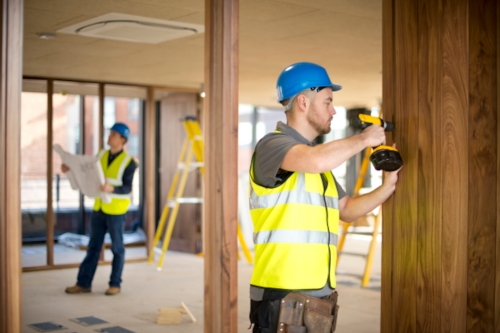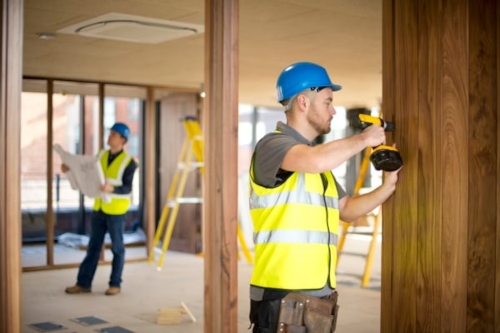
Penetration Sealing Systems
Receive a quote tailored to your needs
Details
- Next training
- Not scheduled yet
- Course type
- Classroom
Course introduction
This course will walk you through why fire systems must be installed correctly and the regulations and standards that surround fire stopping. You'll learn about everything from fire testing, system installation to ducts and dampers and fire sealants.
The afternoon session is practical and delivers a critical understanding of the important issues that must be addressed when conducting installation, maintenance and inspections of penetration sealing systems.
Who is the course for?
The training course would be of interest to anyone involved in the construction industry and of particular use to those involved in the specification and installation, maintenance and inspection of fire stopping and penetration sealing systems, including but not limited to: Risk Assessors, Fire Officers, Architects, Designers, Building Control, Contractors, Site Managers/Supervisors and Specialist Installers.
What will delegates take away?
- A thorough understanding of the regulations and standards applying to fire stopping
- Knowledge of the different types of fire penetration sealing systems and how best to install & maintain
- An appreciation of the importance of critical components such as intumescent sealant and labelling
- A clear understanding of the inspection procedure and pass/fail criteria
The syllabus includes
The course is split into two modules which are each made up of different parts.
Module 1: The KFSC Core Module (Passive Fire Protection)
The morning’s ‘discussion led’ Core Module is divided into three parts:
A: Introduction
Beginning with an introduction and overview of Kiwa Fire Safety Compliance, the module examines the question of ‘Why are you here?’ and the reasons why the installation of fire systems should be undertaken correctly. We examine the consequences of when installation is not carried out competently and correctly; supplemented with real world examples of actual fires.
B: Regulation
We then review and discuss a range of relevant documentation that's available i.e the regulation guidance in the UK and the associated Approved Documents to the Building Regulations. This will cover the Regulatory Reform (Fire Safety) Order (RRO) and the Risk Assessment process.
After looking at and considering the importance of third party certification for products and installers and CE marking, we introduce delegates to the idea of passive and active fire protection, providing brief details about active fire protection and smoke control.
C: Fire & Fire Testing
The third session of the morning starts with asking ‘What is Fire?’ and explains some of the more important terminology and key causes of building fires. Fire tests are also examined with respect to large scale ‘Fire Resistance’ tests and ‘Reaction-to-Fire’ testing, ending with a final look at the European guidance and the European fire testing.
Module 2: The KFSC Penetration Sealing Systems Module
This comprehensive and practical module (delivered in the afternoon) provides the reasoning, knowledge and critical understanding of the important issues to address when conducting installation, maintenance and inspections of penetration sealing systems.
A: Introduction
The module begins with an introduction to the sealing of openings in fire separating elements and informs about relevant regulations, (specifically the Building Regulations and Approved Document B, the Regulatory Reform (Fire Safety) Order picking up on the specific items relating to fire stopping). We then examine how the penetration sealing systems are fire tested both in terms of the non-existent British Standard and the European Standard.
B: Main Session
The primary element of the course concentrates on the key aspects of the installation of many of the different products and systems available, understanding the preparation requirements, how to select the most appropriate systems for the right situation, the various benefits of the most widely used systems and what considerations should be taken with these. The session is supported by several real life/on-site photographic examples.
The course moves on to look at ducts and dampers as variations of service penetrations and what is required to maintain the fire separation between compartments. We will review the installation of some of the different products and systems used for linear gap sealing, including the commonly used intumescent fire sealant, as well as the maintenance of penetration sealing systems, labelling and keeping appropriate records.
Fire Door Inspection Course
Learn how to inspect a fire resisting door set and complete an inspection report.

Fire Rated Timber Door Sets
Gain a critical understanding of the important issues that must be addressed when conducting installation, maintenance and inspections of Fire Rated Timber Doors.

IFE Level 2 Certificate
This intermediate level course provides a foundation in fire safety with modules across a selected range of passive fire protection systems.

External Wall Systems
This course- will help you understand the various cladding systems currently installed on buildings, the materials, fixing methods, finishes, and the different types of cavity barriers and closures.

IFE Level 3 Certificate
This high level course offers a foundation in fire safety as well as modules covering the full range of passive fire protection systems.
